Module 8 - Introduction to Amplifiers
Pages i,
1-1,
1-11,
1-21,
1-31,
2-1,
2-11,
2-21,
2-31,
3-1,
3-11,
3-21,
3-31,
3-41,
3-51,
3-61,
AI-1,
Index
| - |
Matter, Energy,
and Direct Current |
| - |
Alternating Current and Transformers |
| - |
Circuit Protection, Control, and Measurement |
| - |
Electrical Conductors, Wiring Techniques,
and Schematic Reading |
| - |
Generators and Motors |
| - |
Electronic Emission, Tubes, and Power Supplies |
| - |
Solid-State Devices and Power Supplies |
| - |
Amplifiers |
| - |
Wave-Generation and Wave-Shaping Circuits |
| - |
Wave Propagation, Transmission Lines, and
Antennas |
| - |
Microwave Principles |
| - |
Modulation Principles |
| - |
Introduction to Number Systems and Logic Circuits |
| - |
- Introduction to Microelectronics |
| - |
Principles of Synchros, Servos, and Gyros |
| - |
Introduction to Test Equipment |
| - |
Radio-Frequency Communications Principles |
| - |
Radar Principles |
| - |
The Technician's Handbook, Master Glossary |
| - |
Test Methods and Practices |
| - |
Introduction to Digital Computers |
| - |
Magnetic Recording |
| - |
Introduction to Fiber Optics |
| Note: Navy Electricity and Electronics Training
Series (NEETS) content is U.S. Navy property in the public domain. |
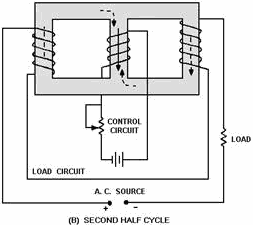
Figure 3-36B. - Three-legged, saturable-core reactor. SECOND Half Cycle
Another approach to solving the problem of load flux affecting control flux is
shown in figure 3-37. Figure 3-37 shows a toroidal saturable-core reactor. The shape
of these cores is a toroid (donut shape). The windings are wound around the cores
so that the load flux aids the control flux in one core and opposes the control
flux in the other core.
During the first half cycle, the flux aids in the left core and opposes in the
right core, as shown in figure 3-37, view (A). During the second half cycle, the
flux opposes in the left core and aids in the right core, as shown in view (B).
Regardless of the amount of load flux or polarity of the load voltage, there is
no net effect of load flux on control flux.
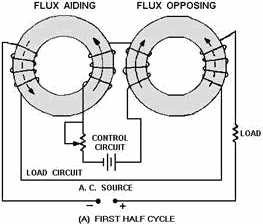
Figure 3-37A. - Toroidal saturable-core reactor. First Half Cycle
3-51
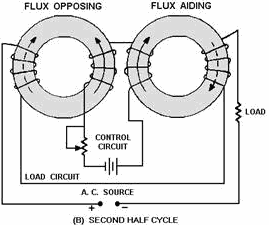
Figure 3-37B. - Toroidal saturable-core reactor. SECOND Half Cycle
Figures 3-36 and 3-37 both represent practical, workable saturable-core
reactors. Circuits similar to these are actually used to control lighting in auditoriums
or electric industrial furnaces. These circuits are sometimes referred to as magnetic
amplifiers, but that is NOT technically correct. a magnetic amplifier differs from
a saturable-core reactor in one important aspect: a magnetic amplifier has a rectifier
in addition to a saturable-core reactor.
Q-42. If the permeability of the core of a coil increases, what happens
to (a) inductance and (b) true power in the circuit?
Q-43. What happens to the permeability of an iron core as the current
increases from the operating point to a large value?
Q-44. If two coils are wound on a single iron core, what will a change
in current in one coil cause in the other coil?
Q-45. What symbol in figure 3-33 indicates a saturable core connecting
two windings?
SIMPLIFIED Magnetic Amplifier CircuitRY
If the saturable-core reactor works, why do we need to add a rectifier to produce
a magnetic amplifier? To answer this question, recall that in NEETS, Module 2 -
Introduction to Alternating Current and Transformers, you were told about hysteresis
loss. Hysteresis loss occurs because the a.c. applied to a coil causes the tiny
molecular magnets (or electron-spin directions) to realign as the polarity of the
a.c. changes. This realignment uses up power. The power that is used for realignment
is a loss as far as the
rest of the circuit is concerned. Because of this hysteresis loss in the saturable-core
reactor, the power gain is relatively low. a rectifier added to the load circuit
will eliminate the hysteresis loss and increase the gain. This is because the rectifier
allows current to flow in only one direction through the load coils.
A simple half-wave magnetic amplifier is shown in figure 3-38. This is a half-wave
magnetic amplifier because it uses a half-wave rectifier. During the first half
cycle of the load voltage, the diode conducts and the load windings develop load
flux as shown in view (A) by the dashed-line arrows. The
3-52
load flux from the two load coils cancels and has no effect on the control flux.
During the second half cycle, the diode does not conduct and the load coils develop
no flux, as shown in view (B). The load flux never has to reverse direction as it
did in the saturable-core reactor, so the hysteresis loss is eliminated.
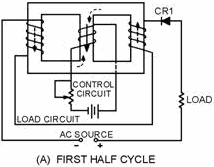
Figure 3-38A. - Simple half-wave magnetic amplifier. First Half Cycle
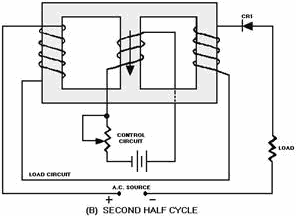
Figure 3-38B. - Simple half-wave magnetic amplifier. SECOND Half Cycle
The circuit shown in figure 3-38 is only able to use half of the load voltage
(and therefore half the possible load power) since the diode blocks current during
half the load-voltage cycle. a full-wave rectifier used in place of CR1 would allow
current flow during the entire cycle of load voltage while still preventing hysteresis
loss.
Figure 3-39 shows a simple full-wave magnetic amplifier. The bridge circuit of
CR1, CR2, CR3, CR4 allows current to flow in the load circuit during the entire
load voltage cycle, but the load current is always in the same direction. This current
flow in one direction prevents hysteresis loss.
3-53
View (A) shows that during the first half cycle of load voltage, current flows
through CR1, the load coils, and CR3. View (B) shows that during the second half
cycle, load current flows through CR2, the load coils, and CR4.
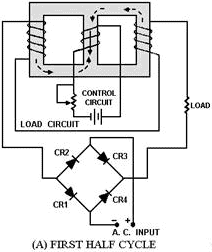
Figure 3-39A. - Simple full-wave magnetic amplifier. First Half Cycle
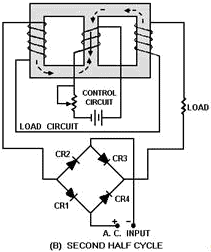
Figure 3-39B. - Simple full-wave magnetic amplifier. SECOND Half Cycle
Up to this point, the control circuit of the magnetic amplifier has been shown
with d.c. applied to it. Magnetic-amplifier control circuits should accept a.c.
input signals as well as d.c. input signals. As shown
3-54
earlier in figure 3-34, a saturable-core reactor has an ideal operating point.
Some d.c. must always be applied to bring the saturable core to that operating point.
This d.c. is called BIAS. the most effective way to apply bias to the saturable
core and also allow a.c. input signals to control the magnetic amplifier is to use
a bias winding. a full-wave magnetic amplifier with a bias winding is shown in figure
3-40.
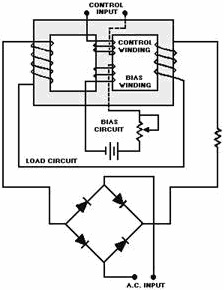
Figure 3-40. - Full-wave magnetic amplifier with bias winding.
In the circuit shown in figure 3-40, the bias circuit is adjusted to set
the saturable-core reactor at the ideal operating point. Input signals, represented
by the a.c. source symbol, are applied to the control input. The true power of the
load circuit is controlled by the control input signal (a.c.)
The block diagram symbol for a magnetic amplifier is shown in figure 3-41. The
triangle is the general symbol for an amplifier. The saturable-core reactor symbol
in the center of the triangle identifies the amplifier as a magnetic amplifier.
Notice the input and output signals shown. The input signal is a small-amplitude,
low-power a.c. signal. The output signal is a pulsating d.c. with an amplitude that
varies. This variation is controlled by the input signal and represents a power
gain of 1000.
3-55
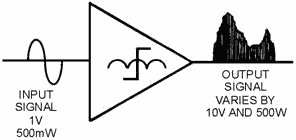
Figure 3-41. - Magnetic amplifier input and output signals.
Some magnetic amplifiers are designed so a.c. goes through the load rather than
pulsating d.c. This is done by placing the load in a different circuit position
with respect to the rectifier. The principle of the magnetic amplifier remains the
same: Control current still controls load current.
Magnetic amplifiers provide a way of accurately controlling large amounts of
power. They are used in servosystems (which are covered later in this training series),
temperature or pressure indicators, and power supplies.
This chapter has presented only the basic operating theory of saturable-core
reactors and magnetic amplifiers. For your convenience, simple schematic diagrams
have been used to illustrate this material. When magnetic amplifiers and saturable-core
reactors are used in actual equipment, the schematics may be more complex than those
you have seen here. Also, you may find coils used in addition to those presented
in this chapter. The technical manual for the equipment in question should contain
the information you need to supplement what you have read in this chapter.
Q-46. At what portion of the magnetization curve should a magnetic
amplifier be operated?
Q-47. How is the effect of load flux on control flux eliminated in
a saturable-core reactor?
Q-48. What is the purpose of the rectifier in a magnetic amplifier?
Q-49. What is used to bias a magnetic amplifier so that the control
winding remains free to accept control (input) signals?
Q-50. List two common usages of magnetic amplifiers.
Summary
This chapter has presented information on differential amplifiers, operational
amplifiers, and magnetic amplifiers. The information that follows summarizes the
important points of this chapter.
A Difference Amplifier is any amplifier with an output signal
dependent upon the difference between the input signals. a two-input, single-output
difference amplifier can be made by combining the common-emitter and common-base
configurations in a single transistor.
3-56
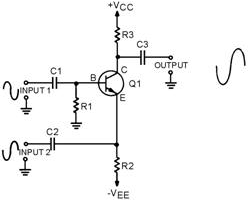
A difference amplifier can have input signals that are IN Phase with each other,
view (A), 180 DEGREES OUT of Phase with each other, view (B), or OUT of Phase BY
SOMETHING OTHER THAN 180 DEGREES with each other, view (C).
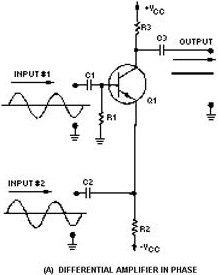
3-57
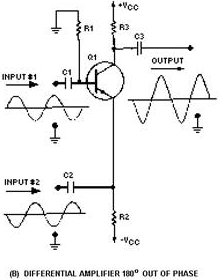
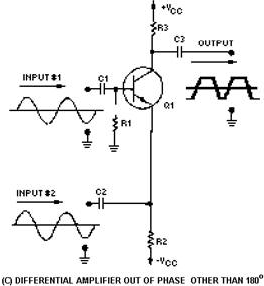
A Differential Amplifier has two possible inputs and two possible
outputs. The combined output signal is dependent upon the difference between the
input signals.
3-58
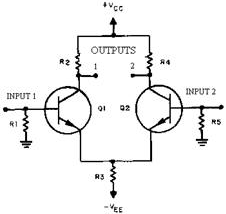
A differential amplifier can be configured with a Single Input and a Single Output
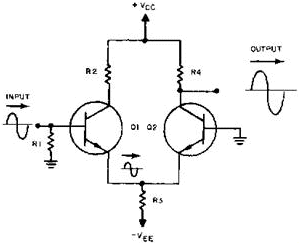
a Single Input and a Differential Output
3-59
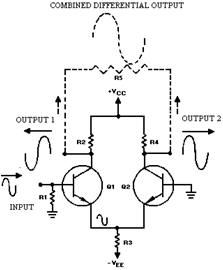
or a Differential Input and a Differential Output.
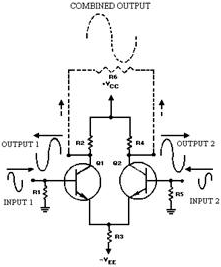
An Operational Amplifier is an amplifier which has very high
gain, very high input impedance, and very low output impedance. An OP AMP is made
from three stages: (1) a differential amplifier, (2) a high-gain voltage amplifier,
and (3) an output amplifier.
3-60
|
























